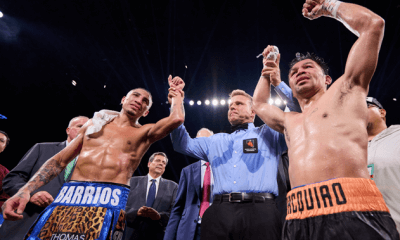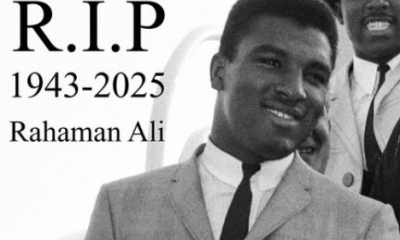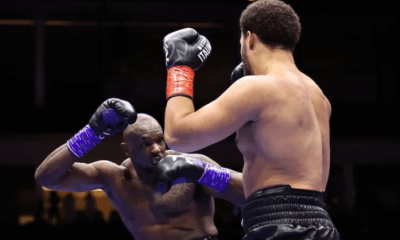Articles of 2005
Losing in Victory with Junior Witter
“The only man who behaved sensibly was my tailor; he took my measurement anew every time he saw me, while all the rest went on with their old measurements and expected them to fit me.” – George Bernard Shaw
Losing in victory and winning in defeat is an incongruity familiar to sports fans, and boxing fans in particular. Junior Witter’s recent points win over Colin Lynes, in defense of his trinity of regional belts – British, Commonwealth and European – moved the Bradford man closer to a mandatory position with the WBC and a shot at the ever-modest Floyd Mayweather, but won him few new friends in the process. In fact, the once overflowing “bandwagon” was missing a number of passengers at Monday morning roll call.
Despite being the onetime darling of the British boxing forums, Witter’s popularity has rarely manifested itself in ticket sales but had, up until last weekend, been upwardly mobile. Long touted as the fighter to unlock Ricky Hatton from his pre-Tszyu comfort zone and erase the smug smile worn by Hatton’s promoter Frank Warren every time the MEN was filled for another Hatton walkover, Witter’s lack of box office appeal was, paradoxically, part of his appeal; Witter was, is, the very antithesis of Hatton.
In truth, Witter’s supporters were as much anti-Warren as pro-Witter. Everyone likes to give the establishment a “bloody nose,” and Frank Warren’s Sports Network – the premier promotional stable in the country over the past decade – continue to fill the role of the perceived establishment in British boxing.
Junior Witter made it easy to believe too. Regrouping and reinvented following his short-notice, overcautious points defeat to Zab Judah in 2000, Witter reeled off 15 knockout wins, the once ugly duckling of British boxing, with the awkward, defensive style, became a noted puncher and one of the country’s most talked about fighters.
Enter Lovemore N’Dou, the loquacious Australian by way of South Africa, and a fighter with global profile, chin, heart and top 15 rankings with the major sanctioning bodies. For six rounds Witter looked sensational. Fast, unorthodox with fearsome power, the usually immoveable N’Dou tasted canvas twice and looked shell-shocked. Witter had arrived; the American audience lapped it up and wondered where Witter had been hiding. I forgot to mention N’Dou didn’t stay down didn’t I? In fact, not only did the Antipodean tough man re-establish himself in the bout but he came close to snatching an implausible points victory, such was Witter’s faltering conclusion to the fight.
Despite a whispered reservation or two about Witter’s failure to finish N’Dou off when so soundly in control and a clearly diminished output from the halfway mark onwards, Witter had arrived as a leading contender. After all, light welterweight rivals Sharmba Mitchell and Miguel Cotto had both failed to put the dints in N’Dou that Witter had and post-fight reports he’d suffered an injury to his hand helped explain his declining output.
Witter (along with stable mate Carl Froch) was swiftly embraced by Golden Boy Promotions and with personal reference from Oscar himself; the latest fighter from Brendan Ingle’s production line had the glow of a finished article. He was certainly peeking out from the long (and sometimes wide) shadow cast by Ricky Hatton, in the months before the “Hitman” fought a naturalised Australian of his own.
Next up was unheralded Ukrainian Andreas Kotelnik, a fighter with a narrow split decision defeat to Souleymane M’Baye on his resume and little else. The expected blow-out didn’t occur and Witter found himself grinding through rounds again, looking ill at ease with Kotelnik’s own cautious approach and officious adherence to a tight defence. Witter, as the aggressor, looked frustrated and at times lacking the invention or stamina to open up the challenger.
Post-fight analysis was kind to Witter, the knockdowns of N’Dou still fresh enough to afford Witter the latitude to write-off the performance as an “off night” and Kotelnik had certainly proved more capable than most had given him credit for.
“It was a very tough encounter,” said Witter. “I caught him with good shots but the speed and power weren't there. But Kotelnik is no bum, he's a world title-class opponent, and I just know I went in there and won it comfortably.”
But for all the retrospective credibility bestowed on him, Kotelnik isn’t a leading contender and Witter had allowed the fight to be too close. A WBC number one position followed and subsequently upheld at the WBC conference thanks to some the behind the scenes hard-ball by promoter Mick Hennessey, but Witter’s substance as a leading contender had been diluted, perhaps irrevocably.
And so with the WBC insisting that Witter still needs to face the Italian Gianluca Branco, a predictable fighter in the ring, a slippery one out of it, the 31-year-old opted to stay active and defend against British contender Colin Lynes. Though the boxing community admired Witter’s willingness to defend his belts, and few would wish to deny the likeable Hornchurch challenger his opportunity at the classic titles, an early knockout was widely predicted.
Lynes, though gutsy and technically sound, lacked the strength or the power to repel Witter and his destructive switch-hitting. Or so the script read. Although only one loss besmirched the Lynes record, a stoppage defeat at the hands of the wild African Samuel Malinga, contentious points victories over the equally awkward Pablo Sarmiento, the scourge of the British lightweight division in recent years, and tall American Jauquin Gallardo highlighted Lynes’ real career horizons despite the IBO “world” belt he held before his challenge.
The British fight fraternity fully expected an explosive return to knockout form for Witter and a further enhancement of his global profile at London’s infamous York Hall, Bethnal Green. A location illustrating the champion’s paucity of ticket buying support, fighting 150 miles from home and closer to the challenger’s backyard.
Sadly for Witter, the widely tipped knockout never arrived, but more worryingly, Lynes was able to navigate the full course with little concern. Only once did Witter appear close to forcing a knockdown and once the opportunity passed the champion became more frustrated. Wilder lunges at Lynes’ classic high guard looked amateurish and as the fight unfolded Witter began absorbing jabs and quick counters too.
Moving into the championship rounds, Witter looked jaded and was unable to compose any of his signature moves or quick-fire combinations. Fleetingly he would return to orthodox boxing, utilising the jab. With this tactic he enjoyed success and looked capable of unhinging the Lynes fight plan with this single weapon, but his desire to look spectacular, to rescue the performance from the mediocrity that had characterised it overwhelmed him and he returned to lunging, forlorn swings.
The challenger couldn’t muster the offence to capitalise on the champion’s failing stamina and lacked the weight of punch to alter the momentum of the fight. But by adhering to a fixed game plan, carefully constructed with trainer Paul Cook, Lynes had survived Witter’s early power plays and grown into the fight. A fight, remember, he was meant to be “blown away” in.
Junior Witter would claim post-fight that a lack of motivation was the pretext for another subdued performance, announcing that he desperately needed a fight he “needed to win” to provide that key mental impetus. “I wasn’t that pleased with my performance. I didn’t put my shots together as well as I would have liked. But a win is a win and I am still British, Commonwealth and European champion and I will be a world champion.
“I need that big fight now against a big name. That is what I am hungry for.”
British mentality ensured Witter’s progression from unheralded underdog to main event fighter attracts a very different type of analysis of his performances. In the spotlight Witter’s flaws, previously disguised by early round knockouts against “B” and “C” class opponents, are being exposed. To compound this, opponents are now far more prepared for his style and fight plan. Lynes, for example, palpably learnt from Kotelnik’s performance versus Witter. Keep tight early and capitalise when he fades.
And fade he did. Witter couldn’t sustain a meaningful offence and appeared to lack the tools to dissect Lyne’s simple game plan. With projected fights with Floyd Mayweather and the spectre of Ricky Hatton and Miguel Cotto still looming large in the division, Junior Witter will need to raise his game far beyond his recent form to make more than a payday out of a world title shot. Though maybe, as he suggests, being the underdog in the fight, fighting on the literal and metaphorical back foot, will bring out the best in him; being required to force the action certainly hasn’t.
Last week, Junior lost a great deal in victory.
-

 Featured Articles3 weeks ago
Featured Articles3 weeks agoThe Hauser Report: Zayas-Garcia, Pacquiao, Usyk, and the NYSAC
-

 Featured Articles2 weeks ago
Featured Articles2 weeks agoOscar Duarte and Regis Prograis Prevail on an Action-Packed Fight Card in Chicago
-

 Featured Articles2 weeks ago
Featured Articles2 weeks agoThe Hauser Report: Cinematic and Literary Notes
-

 Book Review1 week ago
Book Review1 week agoMark Kriegel’s New Book About Mike Tyson is a Must-Read
-

 Featured Articles4 weeks ago
Featured Articles4 weeks agoArne’s Almanac: Pacquiao-Barrios Redux
-

 Featured Articles3 weeks ago
Featured Articles3 weeks agoRemembering Dwight Muhammad Qawi (1953-2025) and his Triumphant Return to Prison
-

 Featured Articles2 weeks ago
Featured Articles2 weeks agoRahaman Ali (1943-2025)
-

 Featured Articles3 days ago
Featured Articles3 days agoMoses Itauma Continues his Rapid Rise; Steamrolls Dillian Whyte in Riyadh













